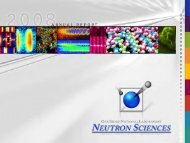ARCS materials - Spallation Neutron Source - Oak Ridge National ...
ARCS materials - Spallation Neutron Source - Oak Ridge National ...
ARCS materials - Spallation Neutron Source - Oak Ridge National ...
Create successful ePaper yourself
Turn your PDF publications into a flip-book with our unique Google optimized e-Paper software.
8488 C P Adams et al<br />
conventional oscillatory, propagating spin waves do not exist in these <strong>materials</strong> [7, 8, 11, 12].<br />
This has greatly hindered a complete description of SDW systems since it is the spin-wave<br />
dispersion that yields values for the microscopic interaction strengths. From this viewpoint<br />
FeGe2, the non-correlated SDW system that is the subject of this study, is an important<br />
exception, since the first inelastic neutron scattering measurements showed that its lowtemperature<br />
magnetic excitations are propagating spin waves or magnons [13, 14]. A simple<br />
Heisenberg model successfully describes the low-energy magnetic dispersion. However, there<br />
appears to be an intrinsic damping of the spin waves even at low temperatures. Damping of this<br />
magnitude is impossible in a purely localized system where magnon–magnon and magnon–<br />
phonon scattering processes dominate, but in metallic systems, such as FeGe2, scattering<br />
can simply arise from the itinerant electrons even at low T . This dual behaviour (spin-wave<br />
dispersion of local moments, significant damping from itinerant electrons) is also found in<br />
the ferromagnetic (FM) metals iron [15] and nickel [16] and La0.85Sr0.15MnO3 [17], a FM<br />
transition metal oxide near the Mott transition.<br />
A further novel feature of FeGe2 is that the dispersion is so anisotropic that it is well<br />
described as quasi-one-dimensional (quasi-1D), unique among metallic magnetic systems [14].<br />
While the entire a-axis magnon dispersion was measured using thermal neutron scattering at<br />
the Chalk River reactor, the much larger energy scale associated with the c-axis magnons<br />
prevented the observation of resolved spin-wave modes in constant-Q scans. A quantitative<br />
determination of the damping (seen as the intrinsic linewidth) and the high-Q dispersion was<br />
not possible. This prompted a continuation of these measurements up to higher energies at the<br />
ISIS spallation source.<br />
FeGe2 has a body-centred tetragonal crystal structure, as in CuAl2, with space group<br />
I4/mcm and two zero-field magnetic phase transitions [18, 19]. One is a second-order Néel<br />
transition from a paramagnetic phase to an incommensurate (IC) SDW state at TN = 289 K<br />
and the other at TC−IC = 263 K is a typical first-order transition from an IC to a commensurate<br />
phase [19]. The ordering wavevector of the commensurate phase, (2π/a)(1, 0, 0), changes to<br />
(2π/a)(1+δ, 0, 0) in the IC phase where δ varies from 0 to ∼0.05. Nearest-neighbour (NN)<br />
iron atoms are 2.478 Å apart along the c-axis and their magnetic moments have FM alignment<br />
in both phases. The next-NN iron atoms are separated by 4.178 Å along the [110] direction with<br />
antiferromagnetic (AFM) alignment of the moments below TC−IC. The higher-temperature IC<br />
phase appears as a long-wavelength modulation of this structure in the basal plane. AFM IC<br />
structures in metals are a strong indication of an interaction that is mediated by the conduction<br />
electrons (indirect exchange). Superexchange through the germanium ions probably also plays<br />
a role in the net AFM basal-plane interaction. In contrast, the NN spacing along the c-axis is so<br />
close to that of elemental iron (2.50 Å) that the primary magnetic interaction in this direction<br />
is probably a direct FM interaction.<br />
2. Experimental results and discussion<br />
To measure the high-energy magnetic excitations and the damping of spin waves in FeGe2, a<br />
new single crystal sample was prepared. It is roughly semi-cylindrical, 15 mm in radius and<br />
40 mm in length, with a mass of 270 g. The measurements were performed at 11 K in the<br />
low-T AFM phase (effectively at T = 0 compared to TN) using HET, a direct-geometry chopper<br />
spectrometer at the ISIS spallation source. The sample was oriented with [010] vertical so the<br />
horizontal banks of detectors were sensitive to momentum transfers Q with (h0l) components,<br />
designated by Qa and Qc. Since HET is a time-of-flight instrument, energy transfer E is<br />
coupled to Q in a way that in general prevents extraction of constant-E and constant-Q scans<br />
(conventionally employed when using a triple-axis spectrometer). Despite this complication,

















